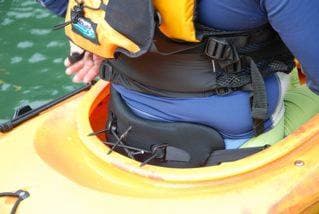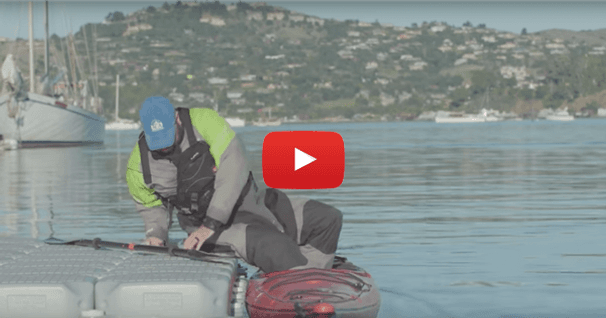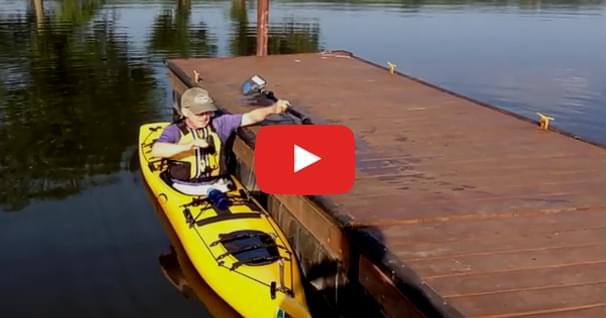Getting In and Out of Your Kayak

"Is there a graceful way to get in an out of my kayak?" The answer may be disappointing to many of you. There is no true graceful way to get in and out of a kayak, but it does get easier and looks more effortless with practice and experience. Here are some tips and techniques to help you feel more comfortable and effortless.
The first thing to do is make sure that you have everything you'll need at hand. Few things are more frustrating than getting ready to shove off and realizing you left something like your water bottle on shore, just out of reach. This is also true of your paddle. Make sure that it is close enough for you to pick up once you're in your boat!
On a Beach or Ramp
The key to an easy launch on the beach is to place your kayak perpendicular to the shoreline so that the front half is in the water and the back half is on the sand. Otherwise, if your boat is completely on the sand once you get in you won't be able to push off into the water. Instead you'll be beached and have to get back out of your kayak and move it closer to the water. This may sound like obvious advice, but I see people beach themselves trying to launch all the time. If you don't want to slide your kayak across the sand, or if you're launching on a cement ramp, or the water is too shallow to be able to slide in, you can float your kayak in a few inches of water. In this case you may have to get a friend to help stabilize your boat while you get in.
TAHE 10'6 & 11'6 SUP-YAK Inflatables
2-in-1 Kayak & Paddle Board complete packages for single or tandem use.
To get in straddle your boat just behind the cockpit rim and sit down on the back of the cockpit. Bring your feet into the cockpit one and a time, straighten your legs and then slide forward into the seat. If you have a kayak in which you have to externally rotate and splay your knees underneath thigh braces you can keep your knees slightly bent as you slide in and then position your thighs under the thigh braces. If you have a sit-on-top all you have to do is swing your legs in, push off and paddle away.
To get out on a beach, aim your kayak in a direction that is perpendicular to the shoreline, and then paddle it up onto the sand so that the boat beaches or stop when your kayak is floating in a few inches of water. Getting out of your kayak is actually much more challenging than getting into your kayak. Start by stepping one foot out at a time so that you end up straddling the kayak or have both feet out and on one side of your boat. The crux move from here is to reach forward, grab the front of your cockpit and pull yourself forward until you have the balance to stand up. What's tough about this move for women is that, in general, our strength is in our hips and legs compared to men who find the bulk of their strength resides in their upper bodies. It's more challenging and takes more strength for women to pull themselves up and out of the kayak than it does for men. The more you practice this move the easier it'll become. Don't worry if you end up falling off to the side onto the beach. It may be easiest to slide your butt onto the sand, roll over onto all fours and push yourself up. No, this doesn't look very smooth, graceful or effortless, but it works! Remember to be gentle with yourself and also be able to laugh at yourself to keep it light.
At a Dock
If you're starting from a dock, one of the easiest ways to get into your boat is to ask a friend to hold your kayak steady while you get in and out. However, if you're on your own, start with your kayak parallel to the dock, preferably wherever it is lowest and closest to the water. Sit down next to your kayak on the dock, place your feet in the cockpit, turn your body toward the bow of the boat while still sitting on the dock, and lower yourself quickly and calmly into the kayak, keeping your weight as low as you can while you do it. Make sure that you have a good and confident hold on the dock before getting into your boat.
To get out at a dock, reverse the above procedure: pull up alongside the dock at its lowest point to the water, hold onto the dock with your hands to steady yourself. Using the dock for balance stand up and step out of the kayak onto the dock. You can also pull yourself, butt first, out of the kayak, keeping your weight low but getting yourself into a sitting position on the dock with your feet still in the boat. If the dock is high up from the water, then it can be trickier to keep your balance while getting in and out, but will become a smooth process with a little practice. The key is to put all of your weight onto the dock as you're stepping out of the boat. Don't be afraid to really lean on that dock.
On a Rocky or Uneven Shoreline
On a rocky, uneven shoreline, you can use your paddle to help stabilize you as you get in and out of your boat. Line your kayak up parallel to the shoreline, and then set your paddle perpendicular to your boat across the back (or stern side) of the cockpit so that half the paddle crosses the boat and the other half lies on the shore. To get in, sit on shore positioned to the front (bow side) of the paddle, and put your feet in the boat. Hold the paddle with your hands about shoulder width apart behind you. Make sure that most of your paddle is on the shore side of you. When it feels stable, press into your paddle and then quickly and calmly shift your butt into the seat, keeping your weight low as you move.
TIP: It's important to place all of your weight on the side of the paddle that is on shore. Don't be afraid to really lean on the paddle for support. If you try to balance your weight evenly across the entire paddle it'll be more difficult to maintain balance because your boat is floating and is not as stable as the shore.
To get out, you can use the same technique in reverse.
Sitting in Your Kayak (Properly)
While we're talking about getting in and out of your kayak I think it's also important to address correct posture while your sitting in your boat. A lot of recreational kayaks have back support that adjusts to lean back which invites you to position yourself as if you were sitting in a recliner watching TV. You may think that this is a comfortable way to sit, but in reality it is very bad for your back and shoulders and can make you more susceptible to injury. Not to mention that it's very difficult to paddle properly while you're leaning back.

To keep your back healthy and sit comfortably in your kayak you'll want to use proper posture. Position the back rest or seat back upright so that it helps you to sit up straight. If you are sitting properly you'll be using your own abdominal muscles to sit upright, with the back rest as an aid to keep you in this position. You want to sit with your chest lifted and your head balanced, not sticking out forward. The balls of your feet should press firmly against the foot pedals and your legs will be externally rotated with your knees out. This open position of the legs makes it more comfortable to sit in an upright position and is easier on your lower back.
If you feel pain or discomfort in your lower back during or after kayaking, it may be because your hips and hamstrings are tight. There are some great paddling stretches that you can do before and after kayaking to increase your flexibility and make your outings comfortable. Stay tuned for a next article on stretches for kayaking!
Related Articles
In this video, we're gonna look at the best ways to get into and out of your kayak because this is when…
In this video, we're gonna look at the best ways to get into and out of your kayak because this is when…
Good morning folks, this is Mike Henebry talking to you from beautiful Lake Springfield in Springfield,…



